In this article, we delve into the popular urban legend that singles out pampas grass as a covert sign of a swinger's home. We'll explore the origin, the myths, and why such a perception has been perpetuated for decades. Let's unfold the layers of this intriguing story.
How Did Pampas Grass and Swinging Become Connected?
During the sexual revolution of the 1960s and 70s, a surprising association emerged. Pampas grass (Cortaderia selloana), seemingly innocuous, started being linked with swinging. A well-circulated myth suggested planting pampas grass in your yard was akin to raising a flag for your swinger status. However, despite its popularity, this claim has no substantial evidence to back it up.
Pampas Grass as a Visual Stimulus
One reason why pampas grass might have become associated with swinging is its unique properties. The long, flexible stalks and fluffy plumes of pampas grass create a visually striking and rhythmic motion when swung in the air.
In the past, the gauchos of Argentina used pampas grass to create this motion as a form of entertainment and dance. The swinging motion of the grass has since become associated with the practice of swinging, both in its traditional and modern interpretations.
The Diversity of the Swinging Community
It is essential to recognize that the swinging community is a diverse group of people with varying preferences and practices. Not all swingers use pampas grass as a signal, and many do not associate the plant with swinging at all.
In fact, some members of the swinging community have even spoken out against the myth, stating that it can create unnecessary attention and misunderstandings.
Why is Pampas Grass linked to Swinging?
The supposed connection between pampas grass and swinging (a practice where partners in a relationship mutually agree to engage in sexual activities with others) has sparked controversy. Despite the buzz, it's important to understand that this association mostly stems from urban legends and pop culture misunderstandings, not any inherent link between the ornamental plant and the lifestyle choice.
The exact origins of the pampas grass-swinger association remain unclear, but it gained popularity during the 1970s and 1980s. According to the urban legend, homeowners who displayed pampas grass in their front yard or garden were supposedly signaling their interest in or participation in swinging activities. Allegedly, the presence of pampas grass served as a discreet symbol to other swingers, indicating a willingness to engage in sexual activities with other couples or individuals.
It is important to emphasize that this association is primarily a myth and lacks factual basis. Pampas grass is a widely appreciated ornamental plant known for its beautiful plumes and graceful appearance. Its alleged connection to swinging is speculative and has been perpetuated through gossip, jokes, and urban legends.
Is Pampas Grass Really a Signal to Swingers?
The notion that a simple plant like pampas grass could be a symbol for swingers is an urban tale that has captivated many over the years. Yet, there's no viable evidence or universally accepted proof to support this fascinating claim. This association relies heavily on speculation and hearsay. Remember, the significance of plants can change dramatically across cultures and communities. While pampas grass has become a trendy plant choice due to its aesthetic appeal, we should resist the urge to attach any specific lifestyle implications to its display in someone's garden or yard.
FAQ
Pampas grass (Cortaderia selloana) serves various purposes in landscaping and decoration. Its feathery plumes and tall, dramatic growth make it a popular choice for adding texture and visual interest to gardens, parks, and larger landscapes. Pampas grass can be used as a focal point or as a backdrop to highlight other plants or landscape features.
Additionally, its dense growth provides privacy screening and serves as a natural windbreak. The plumes of pampas grass can be harvested and used in floral arrangements or dried for decorative purposes, making it a versatile choice for both functional and aesthetic uses.
Pampas grass, with its unique and captivating presence, has taken the world of home decor and interior design by storm. Adding a touch of natural elegance, the tall, feathery plumes in soft, neutral tones imbue any space with a bohemian flair. As statement pieces in home settings, weddings, and events, pampas grass installations elevate the ambiance with their texture and sophistication.
The plant's versatility, pairing well with diverse design styles and color schemes, is a key factor in its trending status. The benefits don't stop at aesthetics - pampas grass requires minimal upkeep and enjoys a long lifespan as a dried ornamental grass, making it a practical option for sustainable decor.
Conclusion
In conclusion, while pampas grass continues to be a captivating ornamental plant, its excessive association with the swinging lifestyle more likely traces back to mere hearsay than any proven facts or behaviors. Its pristine beauty should not be overshadowed by an urban legend that lacks credible basis. Instead of making assumptions or stereotyping based on such myths, let's regard the swinging community with an open and informed perspective.









